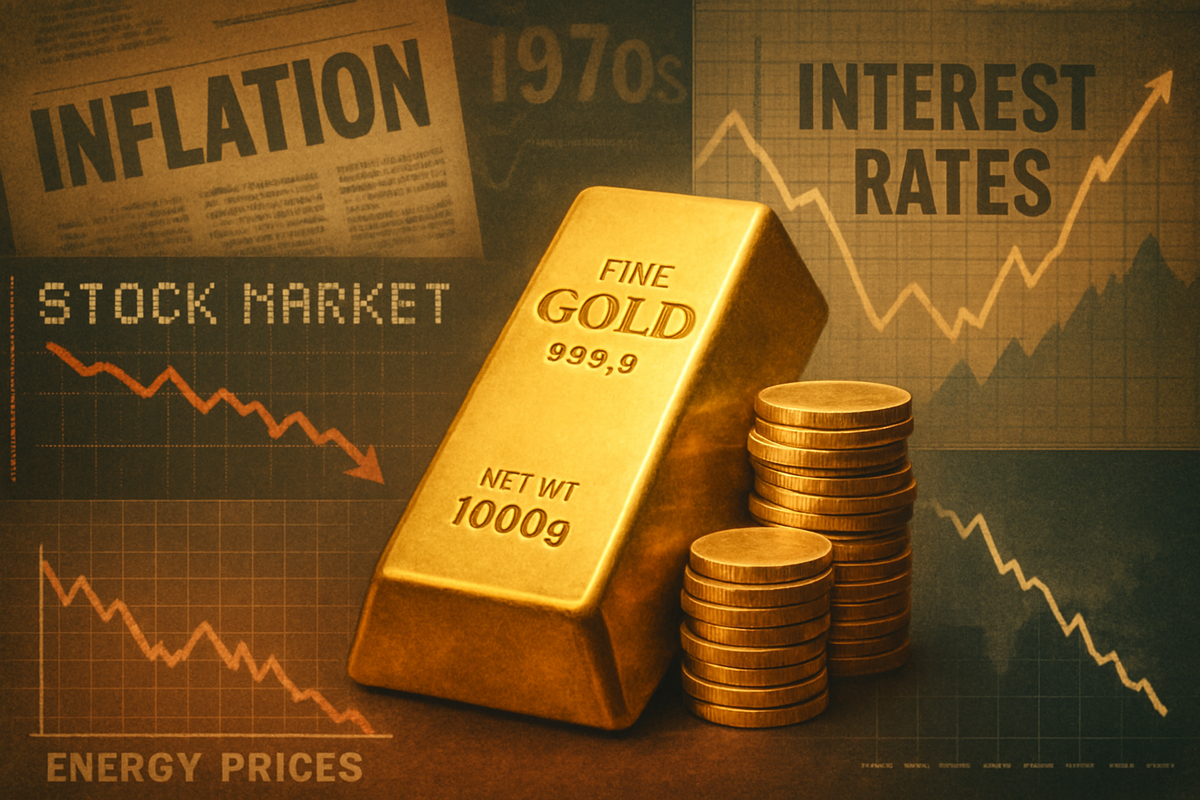
Renowned investor Ray Dalio, founder of Bridgewater Associates, has issued a stark warning to the financial world: the current economic climate bears an unsettling resemblance to the turbulent 1970s, a period marked by rampant inflation, economic stagnation, and geopolitical upheaval. His consistent and increasingly urgent message, reiterated as recently as October 2025, is that investors must bolster their portfolios with gold, which he views as an indispensable hedge against currency debasement and systemic risk. This pronouncement comes amidst a backdrop of surging gold prices, which have recently surpassed $4,000 an ounce, signaling a potential paradigm shift in investment strategy and raising critical questions about the stability of traditional financial assets.
Dalio's comparison is not merely academic; it carries immediate and profound implications for investors, policymakers, and the broader public. If his assessment proves accurate, the coming years could see a sustained period of high inflation, eroding the purchasing power of fiat currencies and challenging conventional portfolio diversification strategies. His advice to allocate as much as 15% of a portfolio to gold suggests a deep-seated concern about the future trajectory of global finance, urging a return to hard assets as a sanctuary from the storm.
Echoes of a Turbulent Decade: Dalio's Rationale for a 1970s Revival
Ray Dalio's conviction that the global economy is mirroring the 1970s is rooted in a comprehensive analysis of several interlocking macroeconomic and geopolitical factors. He points to an environment characterized by "high government spending, and high debt," a scenario he argues is intrinsically damaging to the U.S. dollar and other financial assets. This mirrors the excessive fiscal expansion seen in the 1970s, which ultimately fueled inflationary pressures. Dalio specifically highlights a "classic currency devaluation" akin to the Nixon shock of 1971, where major currencies lose value against tangible assets. The growing burden of servicing unprecedented national debt, which governments may be tempted to inflate away, is identified as a critical precursor to currency weakening.
His views, deeply influenced by his personal experience during the 1971 Nixon shock, have been consistently voiced over recent years, with a notable uptick in urgency throughout 2024 and 2025. His latest remarks at forums like the Greenwich Economic Forum in October 2025 underscore that these comparisons remain central to his current economic outlook. Dalio argues that when there is an abundant supply of debt, holding money in debt instruments becomes an ineffective storehold of wealth, pushing investors towards alternatives.
Beyond monetary policy and debt, Dalio emphasizes the role of geopolitical tensions. He states that today's macro environment, marked by fiscal expansion, inflation volatility, and geopolitical strife, strongly resembles the 1970s. This era saw gold prices surge dramatically amidst global uncertainty. He also observes global power shifts and increasing competition among nations, noting that the "weaponizing the dollar" through sanctions encourages countries to diversify their reserves away from the U.S. currency. This complex interplay of economic and political forces creates a fertile ground for the kind of instability that historically favors gold. The market's initial reaction to these persistent warnings has been a significant surge in gold prices, which have now surpassed $4,000 an ounce, indicating that a growing segment of investors is heeding Dalio's counsel.
Navigating the Golden Tide: Potential Winners and Losers in a Dalio-esque Economy
Should Ray Dalio's prognosis of a 1970s-like economic environment prove accurate, the implications for public companies and various sectors would be profound, creating distinct winners and losers in the market. Companies involved in the extraction, processing, and sale of precious metals, particularly gold, stand to benefit significantly. Gold mining companies like Barrick Gold (NYSE: GOLD) and Newmont (NYSE: NEM) could see substantial increases in their revenues and profitability as the price of gold continues its upward trajectory. Their operational leverage means that even a moderate increase in gold prices can lead to a disproportionately larger increase in their earnings. Furthermore, companies that offer physical gold investment products, such as exchange-traded funds (ETFs) backed by physical gold, would likely experience increased demand.
Conversely, companies highly sensitive to inflation and rising interest rates could face considerable headwinds. Businesses with high operating costs that cannot easily pass these costs on to consumers, or those reliant on cheap financing, would suffer. For instance, sectors with long investment horizons or high capital expenditures, such as certain technology companies or highly leveraged real estate firms, could see their profit margins squeezed and their growth prospects diminish as the cost of capital rises. Consumer discretionary companies might also struggle if inflation erodes household purchasing power, leading to reduced spending on non-essential goods and services.
Moreover, financial institutions holding large portfolios of fixed-income assets could see the real value of these assets diminish with sustained inflation. While banks might benefit from higher interest rate margins in some scenarios, a sudden and sharp increase in rates could also lead to loan defaults and economic slowdown, offsetting any potential gains. Companies with significant international operations might also face challenges due to currency volatility, as Dalio suggests the current environment could lead to widespread currency devaluation, impacting their reported earnings and balance sheets. The shift towards hard assets would also divert capital away from traditional growth stocks, potentially leading to a re-rating of valuations across various market segments.
Beyond the Horizon: Wider Significance and Historical Parallels
Ray Dalio's comparison of the current economic landscape to the 1970s extends beyond mere financial indicators, touching upon broader industry trends, geopolitical shifts, and regulatory considerations. His perspective fits squarely within a growing narrative of de-globalization, increasing national debt burdens, and the evolving role of central banks. The weaponization of the U.S. dollar through sanctions, as Dalio points out, encourages nations to diversify their reserves, accelerating a move away from dollar hegemony and towards alternative storeholds of value, including gold. This trend could have significant ripple effects on global trade dynamics, international finance, and the competitive positioning of various currencies and economies.
Historically, the 1970s were characterized by stagflation—a potent combination of high inflation and stagnant economic growth. During this period, traditional portfolio assets like stocks and bonds performed poorly, while gold experienced a spectacular bull run. Gold prices surged from approximately $35 per ounce at the beginning of the decade to over $800 per ounce by 1980. This historical precedent provides a powerful argument for Dalio's recommendation, suggesting that gold acts as a reliable hedge when conventional investments falter due to monetary debasement and economic uncertainty. The current environment, with its unprecedented levels of national debt, expansive fiscal policies, and persistent inflationary pressures, draws striking parallels to the conditions that precipitated gold's surge five decades ago.
Regulatory and policy implications are also significant. If Dalio's warnings resonate with a broader audience, governments and central banks might face increased pressure to address inflation more aggressively, potentially leading to tighter monetary policies and stricter fiscal discipline. However, given the immense debt loads, the political will to implement such austerity measures could be limited, potentially prolonging the inflationary cycle. Furthermore, the increasing interest in gold as a reserve asset could prompt central banks globally to re-evaluate their own holdings and investment strategies, potentially further fueling demand for the precious metal and reshaping the international monetary system. The potential for a sustained period of "financial repression," where interest rates are kept below the rate of inflation, would further incentivize a shift towards real assets like gold.
The Road Ahead: Navigating Uncertainty and Unlocking Opportunities
Looking ahead, if Ray Dalio's assessment of a 1970s-like economic environment holds true, the financial markets are poised for a period of significant transformation, presenting both formidable challenges and unique opportunities. In the short term, investors can anticipate continued volatility in traditional asset classes, particularly equities and fixed income, as market participants grapple with persistent inflation and evolving central bank policies. The immediate focus will likely remain on inflation data, interest rate decisions, and geopolitical developments, all of which could trigger sharp market reactions. Gold, in this scenario, is expected to maintain its role as a safe haven, potentially experiencing further price appreciation as more investors seek refuge from monetary debasement and systemic risk.
In the long term, strategic pivots will be crucial for both individual investors and institutional portfolios. A sustained inflationary environment necessitates a re-evaluation of asset allocation, favoring real assets over financial assets. This could lead to increased investment in commodities, real estate, and inflation-protected securities, alongside a significant allocation to gold. Corporations may need to adapt by focusing on cost control, supply chain resilience, and pricing power to maintain profitability in an environment of rising input costs. Companies with strong balance sheets and the ability to generate free cash flow will be better positioned to weather economic turbulence.
Potential scenarios range from a controlled disinflation, where central banks successfully tame inflation without triggering a deep recession, to a more severe stagflationary period, where high inflation persists alongside sluggish economic growth. The latter scenario would be particularly challenging for traditional diversified portfolios and would underscore the importance of Dalio's gold recommendation. Market opportunities may emerge in sectors that are historically resilient to inflation, such as utilities, consumer staples, and certain industrial companies with strong pricing power. Conversely, highly leveraged growth companies or those reliant on stable, low-inflation environments could face prolonged struggles. Investors should closely monitor global reserve currency trends, central bank gold accumulation, and any shifts in international trade agreements as indicators of the evolving financial landscape.
A Golden Anchor in Turbulent Waters: Concluding Thoughts
Ray Dalio's persistent and well-articulated warning that the current economic climate mirrors the inflationary and unstable 1970s, coupled with his strong recommendation for gold in investment portfolios, serves as a critical call to action for the financial world. The key takeaways from his analysis center on the dangers of excessive government debt, expansive monetary policies leading to currency debasement, and heightened geopolitical tensions – all factors that historically favor hard assets like gold. The recent surge in gold prices past $4,000 an ounce as of October 2025 suggests that a growing number of investors are acknowledging these systemic risks and seeking the unique counterparty-risk-free security that gold offers.
Moving forward, the market will likely remain highly sensitive to inflation metrics, central bank communications regarding interest rate policy, and the trajectory of global geopolitical events. Investors should be prepared for continued volatility and a potential paradigm shift away from the "everything rally" seen in previous decades towards a more discerning allocation of capital. Dalio's perspective underscores the importance of diversification beyond traditional stocks and bonds, particularly into assets that historically perform well during periods of monetary instability and economic uncertainty.
Ultimately, Dalio's message is a powerful reminder that while economic cycles may seem unique, historical patterns often repeat, albeit with new nuances. His emphasis on gold is not merely a tactical play but a strategic imperative, urging investors to consider a robust defense against potential currency erosion and financial instability. What investors should watch for in the coming months are further signs of persistent inflation, central bank responses, and the continued actions of major global players in diversifying their reserves. In an increasingly uncertain world, Dalio suggests that gold may indeed be the most reliable anchor for a portfolio adrift in turbulent waters.
This content is intended for informational purposes only and is not financial advice





